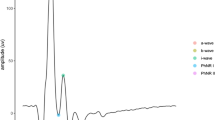Abstract
We developed an automated system to estimate parameters of the Naka-Rushton function based on a heuristic model of the electroretinogram intensity-response series. Data from a population of patients with central retinal vein occlusion were used to examine the ability of the derived parameters to predict the development of neovascularization of the iris. The predictive performance of this automated system in central retinal vein occlusion is comparable to that of a human expert.
Similar content being viewed by others
Abbreviations
- CRVO:
-
central retinal vein occlusion
- NVI:
-
neovascularization of the iris
- ROC:
-
relative operating characteristic
- RP:
-
retinitis pigmentosa
References
Dewar J, M'Kendrick JG. On the physiological action of light. Proc R Soc Edin 1873; 8: 110–4.
Naka KI, Rushton WAH. S-potentials from colour units in the retina of fish (Cyprinidae). J Physiol 1966; 185: 536–55.
Fulton AB, Rushton WAH. The human rod ERG: Correlation with psychophysical responses in light and dark adaptation. Vision Res 1978; 18: 793–800.
Arden GB, Carter RM, Hogg CR, Powell DJ, Ernst WJK, Clover GM, Lyness AL, Quinlan MP. A modified ERG technique and the results obtained in X-linked retinitis pigmentosa. Br J Ophthalmol 1983; 67: 419–30.
Massof RW, Wu L, Finkelstein D, Perry C, Starr SJ, Johnson MA. Properties of electroretinographic intensity-response functions in retinitis pigmentosa. Doc Ophthalmol 1984; 57: 279–96.
Johnson MA, Finkelstein D. The electroretinogram in retinal vein occlusion. Invest Ophthalmol Vis Sci 1985; 26(suppl.): 323.
Johnson MA, Marcus S, Elman MJ, McPhee TJ. Neovascularization in central retinal vein occlusion: Electroretinographic findings. Arch Ophthalmol 1988; 106: 348–52.
Johnson MA, McPhee TJ. Electroretinographic findings in iris neovascularization due to acute central retinal vein occlusion. Arch Ophthalmol 1993; 111: 806–814.
Breton ME, Quinn GE, Keene SS, Dahmen JC, Brucker AJ. Electroretinogram parameters at presentation as predictors of rubeosis in central retinal vein occlusion patients. Ophthalmology 1989; 96: 1343–52.
Bresnick GH, Roecker E, Pulos E. ERG intensity response characteristics in diabetic retinopathy. Invest Ophthalmol Vis Sci 1988; 29(suppl.): 68.
Roecker EB, Pulos E, Bresnick GH, Severns M. Characterization of the electroretinographic scotopicb-wave amplitude in diabetic and normal subjects. Invest Ophthalmol Vis Sci 1992; 33: 1575–83.
Peachey NS, Charles HC, Lee CL, Fishman GA, Cunha-Vaz JG, Smith TR. Electroretinographic findings in sickle cell retinopathy. Arch Ophthalmol 1987; 105: 934–8.
Hood DC, Birch DG. The a-wave of the human electroretinogram and rod receptor function. Invest Ophthalmol Vis Sci 1990; 31: 2070–81.
Breton ME, Montzka D. Empiric limits of rod photocurrent component underlying a-wave response in the electroretinogram. Doc Ophthalmol 1992; 79: 337–61.
Hood DC, Birch DG. A quantitative measure of the electrical activity of human rod photoreceptors using electroretinography. Vis Neurosci 1990; 5: 379–87.
Karpe G. The basis of clinical electroretinography. Acta Ophthalmol 1945; 24(suppl.): 1–118.
Goodman G, Bornschein H. Comparative electroretinographic studies in congenital night blindness and total color blindness. Arch Ophthalmol 1957; 58: 174–82.
Biersdorf WR. Luminance-duration relationships in the light-adapted electroretinogram. J Opt Soc Am 1958; 48: 412–7.
Rendahl I. The scotopic a-wave of the human electroretinogram. Acta Ophthalmol 1958; 36: 329–43.
Peachey NS, Alexander KR, Fishman GA. The luminance-response function of the dark-adapted human electroretinogram. Vision Res 1981; 29: 263–70.
Marmor MF, Arden GB, Nilsson SEG, Zrenner E. Standard for clinical electroretinography. Arch Ophthalmol 1989; 107: 816–9; Reprinted with permission in Doc Ophthalmol 1989; 303–311.
Severns ML, Johnson, MA. The variability of the b-wave of the electroretinogram. Doc Ophthalmol 1993 (in press).
Clarkson JC. Central retinal vein occlusion. In Ryan SJ, ed. Retina. St. Louis: CV Mosby, 1989; 2: 421–6.
Press WH, Flannery BP, Teukolsky SA, Vetterling WT. Numerical recipes. Cambridge: Cambridge University Press, 1988: 305–9.
Hoaglin DC, Mosteller F, Tukey JW. Understanding robust and exploratory data analysis. New York: John Wiley & Sons, 1983.
Green DM, Swets JA. Signal detection theory and psychophysics. New York: Krieger, 1974: 45–9.
Bamber D. The area above the ordinal dominance graph and the area below the receiver operating characteristic graph. J Math Psychol 1957; 12: 387–415.
Hanley JA, McNeil BJ. The meaning and use of the area under the receiver operating characteristic (ROC) curve. Radiology 1982; 143: 29–36.
Hanley JA, McNeil BJ. A method of comparing the area under two ROC curves derived from the same data. Radiology 1983; 148: 839–43.
Aylward GW. A simple method of fitting the Naka-Rushton equation. Clin Vision Sci 1989; 4: 275–7.
Wali N, Leguire LE. On the method for fitting the Naka-Rushton equation: Corrections to Aylward. Clin Vision Sci 1990; 6: 79.
Hood DC, Birch DG. A computational model of the amplitude and implicit time of the b-wave of the human ERG. Vis Neurosci 1992; 8: 107–26.
Author information
Authors and Affiliations
Rights and permissions
About this article
Cite this article
Severns, M.L., Johnson, M.A. The care and fitting of Naka-Rushton functions to electroretinographic intensity-response data. Doc Ophthalmol 85, 135–150 (1993). https://doi.org/10.1007/BF01371129
Accepted:
Issue Date:
DOI: https://doi.org/10.1007/BF01371129




